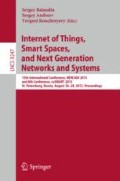Abstract
The state-of-the-art adaptive combined (space-time) signal processing methods provide either optimum results under unrealistic computational times and efforts, or affordable computations under severe service degradation. This paper first analyses the existing methods and derives the motivation for the novel approach to creation of combined systems of the space-time-adaptive processing with dependent component adaptation. Then the generic derivations of the weighting factors calculation is shown step by step for a two-component (space-time) combined processing system with dependent components adaptation. Finally, numerical simulations show that through the proposed method it is possible to suppress wideband and narrowband interference, even if the number of interfering signals is higher than the number of antenna array elements.
Access this chapter
Tax calculation will be finalised at checkout
Purchases are for personal use only
Preview
Unable to display preview. Download preview PDF.
References
Fette, B.A.: Cognitive Radio Technology. Academic Press, New York (2009)
Jayaweera, S.K.: Signal Processing for Cognitive Radios. John Wiley & Sons, New York (2014)
Matin, M.: Handbook of Research on Progressive Trends in Wireless Communications and Networking. IGI Globa (2014)
Monzingo, R., Miller, T.: Introduction to Adaptive Arrays. Wiley and Sons, New York (1980)
Haykin, S., Adali, T.: Adaptive Signal Processing: Next Generation Solutions. Wiley-IEEE Press, New York (2010)
Christodoulou, C.G., Blaunstein, N.: Radio Propagation and Adaptive Antennas for Wireless Communication Networks. John Wiley & Sons, New York (2014)
Grigoryev, V., Kuzichkin, A., Khvorov, I.: Algorithms of combined signal processing. In: The 2nd International Conference on Satellite Communications, ICSC 1996 (1996)
Grigoryev, V., Kuzichkin, A., Stadinchuk, A.: Application of methods of combined signal processing in systems of mobile communication. In: The Third International Conference on Satellite Communications, ICSC 1998 (1998)
Grigoryev, V., Kurichkin, S.: The analysis of construction variants of onboard systems of combined signals processing. In: The Third International Conference on Satellite Communications, ICSC 1998 (1998)
Klemm, R.: Principles of Space-Time Adaptive Processing. IEEPress, Bodmin (2002)
Godara, L.: Application of Antenna Arrays to Mobile Communications, Part II: Beam-Forming and Direction-of-Arrival Considerations. Proceedings of the IEEE 85(8), 1195–1245 (1997)
Wu, D., Zhu, D., Shen, M., Zhu, Z.: Time-varying space-time autoregressive filtering algorithm for space-time adaptive processing. Radar, Sonar & Navigation, IET 6(4), 213–221 (2012)
Xiong, Z.-Y., Xu, Z.-H., Zhang, L., Xiao, S.-P.: A recursive algorithm for the design of array antenna in STAP application. In: ET International Radar Conference (2013)
Lai, P., Lu, R., Liu, Y.: Space-time interference suppression technology based on sub-band blind adaptive array processing. In: 4th IEEE International Conference on Information Science and Technology (ICIST) (2014)
El Khatib, A., Assaleh, K., Mir, H.: Space-Time Adaptive Processing Using Pattern Classification. IEEE Transactions on Signal Processing 63(3), 766–779 (2015)
Yang, K., Zhang, Y., Mizuguchi, Y.: Spatio-temporal signal subspace-based subband space-time adaptive antennas. In: International Symposium on Antennas and Propagation, Fukuoka, Japan (2000)
Ortega, J.M., Rheinboldt, W.C.: Iterative solution of nonlinear equations in several variables, Computer science and applied mathematics. Academic Press (1970)
Author information
Authors and Affiliations
Corresponding authors
Editor information
Editors and Affiliations
Rights and permissions
Copyright information
© 2015 Springer International Publishing Switzerland
About this paper
Cite this paper
Grigoryev, V., Khvorov, I. (2015). Combined Adaptive Spatial-Temporal Signal Processing System Based on Sequential Circuit with Dependent Component Adaptation. In: Balandin, S., Andreev, S., Koucheryavy, Y. (eds) Internet of Things, Smart Spaces, and Next Generation Networks and Systems. ruSMART NEW2AN 2015 2015. Lecture Notes in Computer Science(), vol 9247. Springer, Cham. https://doi.org/10.1007/978-3-319-23126-6_56
Download citation
DOI: https://doi.org/10.1007/978-3-319-23126-6_56
Published:
Publisher Name: Springer, Cham
Print ISBN: 978-3-319-23125-9
Online ISBN: 978-3-319-23126-6
eBook Packages: Computer ScienceComputer Science (R0)

